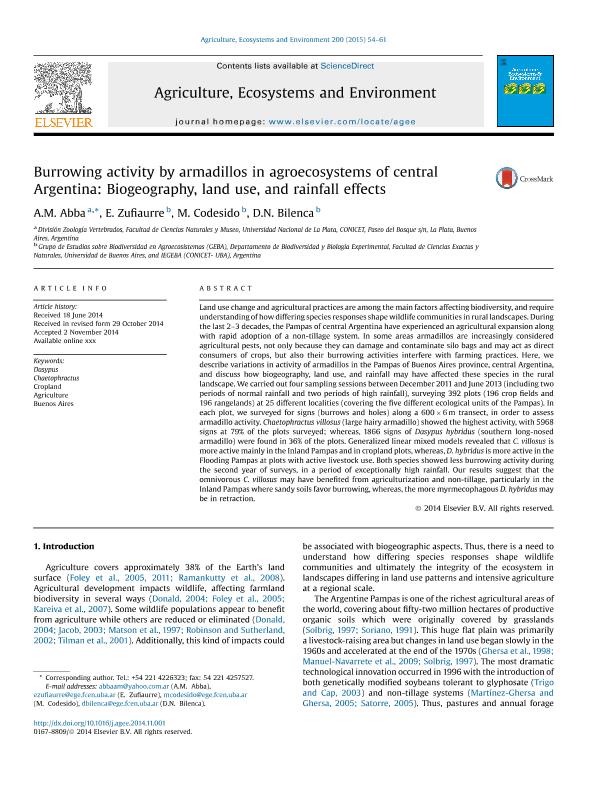Mostrar el registro sencillo del ítem
dc.contributor.author
Abba, Agustin Manuel

dc.contributor.author
Zufiaurre, Emmanuel

dc.contributor.author
Codesido, Mariano

dc.contributor.author
Bilenca, David Norberto

dc.date.available
2018-03-22T16:42:05Z
dc.date.issued
2015-02
dc.identifier.citation
Abba, Agustin Manuel; Zufiaurre, Emmanuel; Codesido, Mariano; Bilenca, David Norberto; Burrowing activity by armadillos in agroecosystems of central Argentina: Biogeography, land use, and rainfall effects; Elsevier Science; Agriculture, Ecosystems and Environment; 200; 2-2015; 54-61
dc.identifier.issn
0167-8809
dc.identifier.uri
http://hdl.handle.net/11336/39674
dc.description.abstract
Land use change and agricultural practices are among the main factors affecting biodiversity, and require understanding of how differing species responses shape wildlife communities in rural landscapes. During the last 2-3 decades, the Pampas of central Argentina have experienced an agricultural expansion along with rapid adoption of a non-tillage system. In some areas armadillos are increasingly considered agricultural pests, not only because they can damage and contaminate silo bags and may act as direct consumers of crops, but also their burrowing activities interfere with farming practices. Here, we describe variations in activity of armadillos in the Pampas of Buenos Aires province, central Argentina, and discuss how biogeography, land use, and rainfall may have affected these species in the rural landscape. We carried out four sampling sessions between December 2011 and June 2013 (including two periods of normal rainfall and two periods of high rainfall), surveying 392 plots (196 crop fields and 196 rangelands) at 25 different localities (covering the five different ecological units of the Pampas). In each plot, we surveyed for signs (burrows and holes) along a 600. ×. 6. m transect, in order to assess armadillo activity. Chaetophractus villosus (large hairy armadillo) showed the highest activity, with 5968 signs at 79% of the plots surveyed; whereas, 1866 signs of Dasypus hybridus (southern long-nosed armadillo) were found in 36% of the plots. Generalized linear mixed models revealed that C. villosus is more active mainly in the Inland Pampas and in cropland plots, whereas, D. hybridus is more active in the Flooding Pampas at plots with active livestock use. Both species showed less burrowing activity during the second year of surveys, in a period of exceptionally high rainfall. Our results suggest that the omnivorous C. villosus may have benefited from agriculturization and non-tillage, particularly in the Inland Pampas where sandy soils favor burrowing, whereas, the more myrmecophagous D. hybridus may be in retraction.
dc.format
application/pdf
dc.language.iso
eng
dc.publisher
Elsevier Science

dc.rights
info:eu-repo/semantics/openAccess
dc.rights.uri
https://creativecommons.org/licenses/by-nc-nd/2.5/ar/
dc.subject
Agriculture
dc.subject
Buenos Aires
dc.subject
Chaetophractus
dc.subject
Cropland
dc.subject
Dasypus
dc.subject.classification
Otras Ciencias Biológicas

dc.subject.classification
Ciencias Biológicas

dc.subject.classification
CIENCIAS NATURALES Y EXACTAS

dc.title
Burrowing activity by armadillos in agroecosystems of central Argentina: Biogeography, land use, and rainfall effects
dc.type
info:eu-repo/semantics/article
dc.type
info:ar-repo/semantics/artículo
dc.type
info:eu-repo/semantics/publishedVersion
dc.date.updated
2018-03-22T13:04:10Z
dc.journal.volume
200
dc.journal.pagination
54-61
dc.journal.pais
Países Bajos

dc.journal.ciudad
Amsterdam
dc.description.fil
Fil: Abba, Agustin Manuel. Universidad Nacional de la Plata. Facultad de Ciencias Naturales y Museo. Departamento Científico Zoología Vertebrados; Argentina. Consejo Nacional de Investigaciones Científicas y Técnicas; Argentina
dc.description.fil
Fil: Zufiaurre, Emmanuel. Consejo Nacional de Investigaciones Científicas y Técnicas. Oficina de Coordinación Administrativa Ciudad Universitaria. Instituto de Ecología, Genética y Evolución de Buenos Aires. Universidad de Buenos Aires. Facultad de Ciencias Exactas y Naturales. Instituto de Ecología, Genética y Evolución de Buenos Aires; Argentina
dc.description.fil
Fil: Codesido, Mariano. Consejo Nacional de Investigaciones Científicas y Técnicas. Oficina de Coordinación Administrativa Ciudad Universitaria. Instituto de Ecología, Genética y Evolución de Buenos Aires. Universidad de Buenos Aires. Facultad de Ciencias Exactas y Naturales. Instituto de Ecología, Genética y Evolución de Buenos Aires; Argentina
dc.description.fil
Fil: Bilenca, David Norberto. Consejo Nacional de Investigaciones Científicas y Técnicas. Oficina de Coordinación Administrativa Ciudad Universitaria. Instituto de Ecología, Genética y Evolución de Buenos Aires. Universidad de Buenos Aires. Facultad de Ciencias Exactas y Naturales. Instituto de Ecología, Genética y Evolución de Buenos Aires; Argentina
dc.journal.title
Agriculture, Ecosystems and Environment

dc.relation.alternativeid
info:eu-repo/semantics/altIdentifier/doi/http://dx.doi.org/10.1016/j.agee.2014.11.001
dc.relation.alternativeid
info:eu-repo/semantics/altIdentifier/url/https://www.sciencedirect.com/science/article/pii/S0167880914004885
Archivos asociados
